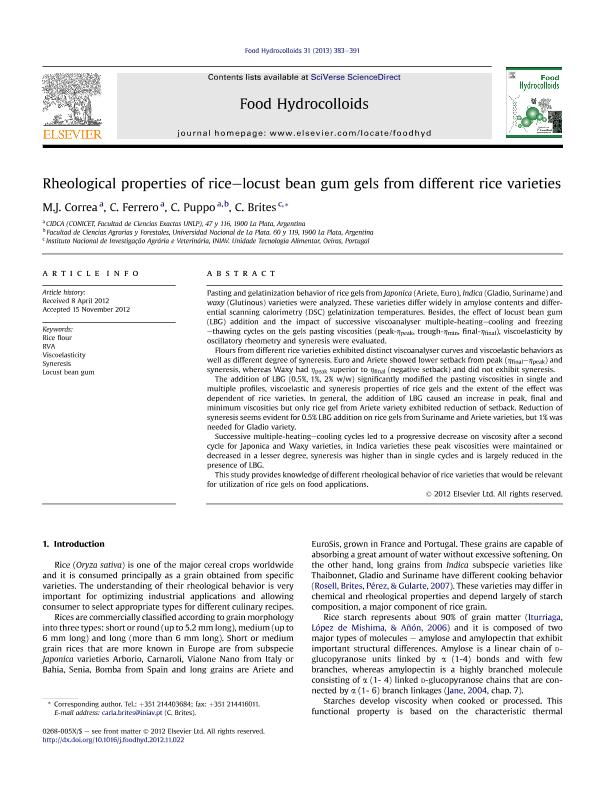Mostrar el registro sencillo del ítem
dc.contributor.author
Correa, María Jimena

dc.contributor.author
Ferrero, Cristina

dc.contributor.author
Puppo, Maria Cecilia

dc.contributor.author
Brites, C.
dc.date.available
2019-11-04T18:07:52Z
dc.date.issued
2013-06
dc.identifier.citation
Correa, María Jimena; Ferrero, Cristina; Puppo, Maria Cecilia; Brites, C.; Rheological properties of rice-locust bean gum gels from different rice varieties; Elsevier; Food Hydrocolloids; 31; 2; 6-2013; 383-391
dc.identifier.issn
0268-005X
dc.identifier.uri
http://hdl.handle.net/11336/87933
dc.description.abstract
Pasting and gelatinization behavior of rice gels from Japonica (Ariete, Euro), Indica (Gladio, Suriname) and waxy (Glutinous) varieties were analyzed. These varieties differ widely in amylose contents and differential scanning calorimetry (DSC) gelatinization temperatures. Besides, the effect of locust bean gum (LBG) addition and the impact of successive viscoanalyser multiple-heating-cooling and freezing-thawing cycles on the gels pasting viscosities (peak-ηpeak, trough-ηmin, final-ηfinal), viscoelasticity by oscillatory rheometry and syneresis were evaluated.Flours from different rice varieties exhibited distinct viscoanalyser curves and viscoelastic behaviors as well as different degree of syneresis. Euro and Ariete showed lower setback from peak (ηfinal-ηpeak) and syneresis, whereas Waxy had ηpeak superior to ηfinal (negative setback) and did not exhibit syneresis.The addition of LBG (0.5%, 1%, 2% w/w) significantly modified the pasting viscosities in single and multiple profiles, viscoelastic and syneresis properties of rice gels and the extent of the effect was dependent of rice varieties. In general, the addition of LBG caused an increase in peak, final and minimum viscosities but only rice gel from Ariete variety exhibited reduction of setback. Reduction of syneresis seems evident for 0.5% LBG addition on rice gels from Suriname and Ariete varieties, but 1% was needed for Gladio variety.Successive multiple-heating-cooling cycles led to a progressive decrease on viscosity after a second cycle for Japonica and Waxy varieties, in Indica varieties these peak viscosities were maintained or decreased in a lesser degree, syneresis was higher than in single cycles and is largely reduced in the presence of LBG.This study provides knowledge of different rheological behavior of rice varieties that would be relevant for utilization of rice gels on food applications.
dc.format
application/pdf
dc.language.iso
eng
dc.publisher
Elsevier

dc.rights
info:eu-repo/semantics/openAccess
dc.rights.uri
https://creativecommons.org/licenses/by-nc-sa/2.5/ar/
dc.subject
Rice flour
dc.subject
RVA
dc.subject
Viscoelasticity
dc.subject
Syneresis
dc.subject
Locust bean gum
dc.subject.classification
Alimentos y Bebidas

dc.subject.classification
Otras Ingenierías y Tecnologías

dc.subject.classification
INGENIERÍAS Y TECNOLOGÍAS

dc.title
Rheological properties of rice-locust bean gum gels from different rice varieties
dc.type
info:eu-repo/semantics/article
dc.type
info:ar-repo/semantics/artículo
dc.type
info:eu-repo/semantics/publishedVersion
dc.date.updated
2019-11-01T19:48:17Z
dc.journal.volume
31
dc.journal.number
2
dc.journal.pagination
383-391
dc.journal.pais
Países Bajos

dc.journal.ciudad
Amsterdam
dc.description.fil
Fil: Correa, María Jimena. Provincia de Buenos Aires. Gobernación. Comisión de Investigaciones Científicas. Centro de Investigación y Desarrollo en Criotecnología de Alimentos. Consejo Nacional de Investigaciones Científicas y Técnicas. Centro Científico Tecnológico Conicet - La Plata. Centro de Investigación y Desarrollo en Criotecnología de Alimentos. Universidad Nacional de la Plata. Facultad de Ciencias Exactas. Centro de Investigación y Desarrollo en Criotecnología de Alimentos; Argentina
dc.description.fil
Fil: Ferrero, Cristina. Provincia de Buenos Aires. Gobernación. Comisión de Investigaciones Científicas. Centro de Investigación y Desarrollo en Criotecnología de Alimentos. Consejo Nacional de Investigaciones Científicas y Técnicas. Centro Científico Tecnológico Conicet - La Plata. Centro de Investigación y Desarrollo en Criotecnología de Alimentos. Universidad Nacional de la Plata. Facultad de Ciencias Exactas. Centro de Investigación y Desarrollo en Criotecnología de Alimentos; Argentina
dc.description.fil
Fil: Puppo, Maria Cecilia. Provincia de Buenos Aires. Gobernación. Comisión de Investigaciones Científicas. Centro de Investigación y Desarrollo en Criotecnología de Alimentos. Consejo Nacional de Investigaciones Científicas y Técnicas. Centro Científico Tecnológico Conicet - La Plata. Centro de Investigación y Desarrollo en Criotecnología de Alimentos. Universidad Nacional de la Plata. Facultad de Ciencias Exactas. Centro de Investigación y Desarrollo en Criotecnología de Alimentos; Argentina
dc.description.fil
Fil: Brites, C.. Instituto Nacional de Investigação Agrária E Veterinária; Portugal
dc.journal.title
Food Hydrocolloids

dc.relation.alternativeid
info:eu-repo/semantics/altIdentifier/url/http://www.sciencedirect.com/science/article/pii/S0268005X12002871
dc.relation.alternativeid
info:eu-repo/semantics/altIdentifier/doi/http://dx.doi.org/10.1016/j.foodhyd.2012.11.022
Archivos asociados
